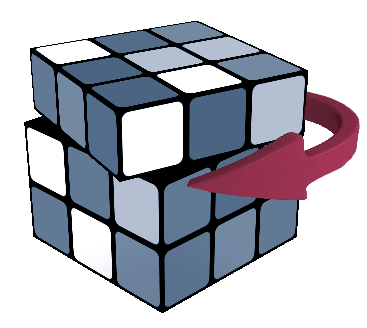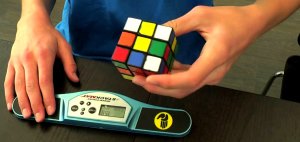Different Rubik’s Cube Solving Methods
Whether you’ve just learnt how to solve the cube or you’re a veteran, there are many different methods that are available, each with their own unique opportunities to improve in speed (if that’s what you want to do). I’m going to talk about some of the methods people have created to address one of two different aspects – Efficiency and ease-of-learning.
Efficiency / Speed
 There have been many methods created to maximise speed and set records. For some, solving the Rubik’s Cube, although a massive achievement, isn’t enough. Puzzlers may choose to either practice the speed aspect of the cube whilst others may choose to discover different modifications and different puzzles. There’s only so far that the original method can carry a solver in terms of speed, so many more have been created that, whilst increasing the number of algorithms required to learn, have unlocked potential that has before been thought impossible, such as below 10 second solves.
There have been many methods created to maximise speed and set records. For some, solving the Rubik’s Cube, although a massive achievement, isn’t enough. Puzzlers may choose to either practice the speed aspect of the cube whilst others may choose to discover different modifications and different puzzles. There’s only so far that the original method can carry a solver in terms of speed, so many more have been created that, whilst increasing the number of algorithms required to learn, have unlocked potential that has before been thought impossible, such as below 10 second solves.
Advanced CFOP / Fridrich Method
The main method that people advance to off of beginner methods is CFOP. In fact, some beginner methods use some, if not all, of CFOP’s steps in a slightly easier to understand way. Since it became popular, CFOP has always been the Old Faithful of speedcubing – Simple to learn and, although harder to get good at, very rewarding to those who put in the time. Nobody has been able to devise a more efficient method and although some different methods are still popular and incredibly fast times are possible on those as well, CFOP has always been the main method. Perhaps one of the reasons for its popularity is the logical sense that each step makes. The steps involve building the foundations for the first two layers and then pairing up pieces before inserting them around the foundations to solve the first two layers. Then the last layer is tackled by learning the algorithms to solve the cube in two extra steps. All steps of this method become incredibly simple once algorithms have been drilled and the solver has practiced enough, which probably contributes to its unbelievable speed capacities.
Learn the Advanced Fridrich Method »
Roux Method

Roux is a metho that is a large competitor with CFOP. The fastest Roux solver is currently 15th in the World for a single solve, although the same solve was 3rd in the World when it was set. He has also used the method to win many UK and European competitions, proving that it truly is a competitor to CFOP. Whereas CFOP relies on mainly on look-ahead with only a small focus on intuitive solving (the F2L stage, although it could be argued that it is intuitive, has only a certain number of possible cases for each pair that eventually become muscle memory, whereas the cross has many more possibilities), two major steps in Roux involve intuitive block building. Also, being able to accurately turn the cube fast is arguably more important in Roux. In CFOP, the last two steps have algorithms that can be drilled normally, but Roux’s last step used the M slice and U moves only, which make accurate turning even more vital so as to avoid pops. In terms of ease of understanding, CFOP is more structured for the average beginner than Roux is. Roux uses some pretty advanced techniques such as block building right off the bat, so almost all people who use Roux have switched to it after getting familiar and fairly quick with CFOP.
Metha Method
The Metha method method was made for 3x3 by Yash Mehta, but it has been adapted to big cubes by Matthew Hinton with the Mehta-MH method, and it also works on Square-1, but the details for that are still being worked out.
There are multiple versions of Mehta. The main group is Mehta-OS, OS standing for Option Select, and the advanced section is Mehta-TDR, named so after the first varying step, TDR, in that path.
Our Metha tutorial presents Mehta 6CO, 6CP, L5EP path, which is the recommended path for a solver that is not highly advanced. It is also the base for Mehta-OS and is most likely the only path to have fully genned beginners' algorithms.
ZZ
ZZ method tries to shorten CFOP’s move count and improve finger tricking opportunities. It involves orienting edges as part of the first stage to remove the need for F, B or D moves. The last layer can then be solved in one look as all four edges are oriented, however there are 493 algorithms to learn to do this; something that only a few dozen people have been able to learn in its entirety. You could use simple OLL and PLL from the CFOP method which would mean you only need to learn 7 algorithms for OLL instead of 57, however when the difficulty of the first step in comparison to the lower algorithm requirement means that, for most people, CFOP comes out on top.
Ease-Of-Learning
Some methods are focused at beginners, those who are only now holding a cube in their hands and wanting to learn how to solve the puzzle for the first time. These methods generally focus on avoiding algorithms (which can be confusing for beginners) and solving the cube as logically as possible, so the solver can see what is happening and how it is happening. Any algorithms that are used are normally very simple ones that need repeating a few times to get the desired position. All speedcubers have started with one of these methods before moving on to more advanced methods, whereas these methods may be sufficient for general puzzlers.
Beginner CFOP/Fridrich, also called Layer-By-Layer

Layer-by-layer Rubik’s Tutorial »
There is a beginner version of the CFOP method which minimizes algorithms as much as possible. It is popular due to its logical progression, despite being fairly challenging at times. Concept such as building the cross are difficult to explain at first, which can unfortunately put many people off at the first hurdle. However, those who persevere will see that the cross is probably one of, if not the most confusing stages. Then normal progression for this method is to then use one algorithm over and over to eventually put each corner in to its correct position. Then, two algorithms are used to finish the second layer. This is normally a massive confidence boost for beginners, as the cube looks 2/3 solved. The last two steps can be difficult to understand because there isn’t much opportunity to avoid algorithm learning. The simplest form of OLL is to use one of two algorithms to orient all of the edges before repeating one algorithm until you reach a desired position, where repeating the same algorithm one last time will complete the stage. PLL, similarly to OLL, has many different variations that all achieve the same thing whilst simplifying the last step, for example some beginner variations of OLL result in one of only 3 or 4 different PLL’s compared to the possible 21 with normal OLL. One of the simplest of the PLL explanations is by, once again, repeating two different algorithms after positioning the U layer correctly each time. When time is not an important factor for the solver, the entirety of CFOP can be simplified heavily with the intention of doing what the solver wants – To solve the cube, in the majority of cases for the first time.
There is also a method which solves the corners first, but in terms of logical and easy to follow methods for beginners, most available on the internet are some variation of the beginner CFOP method listed above.
Solve the Rubik’s Cube Blindfolded »